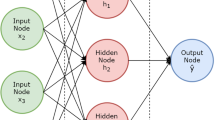Abstract
This paper investigates the problem of predicting daily returns based on five Canadian exchange rates using artificial neural networks and EGARCH-M models. First, the statistical properties of five daily exchange rate series (US Dollar, German Mark, French Franc, Japanese Yen and British Pound) are analysed. EGARCH-M models on the Generalised Error Distribution (GED) are fitted to the return series, and serve as comparison standards, along with random walk models. Second, backpropagation networks (BPN) using lagged returns as inputs are trained and tested. Estimated volatilities from the EGARCH-M models are used also as inputs to see if performance is affected. The question of spillovers in interrelated markets is investigated with networks of multiple inputs and outputs. In addition, Elman-type recurrent networks are also trained and tested. Comparison of the various methods suggests that, despite their simplicity, neural networks are similar to the EGARCH-M class of nonlinear models, but superior to random walk models, in terms of insample fit and out-of-sample prediction performance.
Similar content being viewed by others
References
Gallant A, Hsieh D, Tauchen G. On fitting a recalcitrant series: The pound/dollar exchange rate, 1974–1983. In W Bartnett et al., eds, Nonparametric and Semiparametric Methods in Econometrics and Statistics. Cambridge University Press, New York, 1991
Baillie R, McMahon P. The Foreign Exchange Market: Theory and econometric evidence. Cambridge University Press, Cambridge, MA, 1989
White H, Gallant A, Hornik K, Stinchcombe M, Wooldridge J. Artificial Neural Networks: Approximation and Learning Theory. Blackwell, Cambridge, MA, 1992
Ballie R, Bollerslev T. The message in daily exchange rates: A conditional-variance tale. Journal of Business and Economic Statistics 1989; 7(3): 297–305
Hsieh D. Modeling heteroskedasticity in daily foreign-exchange rates. Journal of Business and Economic Statistics 1989; 7(3): 307–317
Domowitz I, Hakkio C. Conditional variance and risk premium in foreign exchange market. Journal of International Economics 1985; 19: 47–66
Akgiray V, Booth G. Modeling the stochastic behaviour of Canadian foreign exchange rates. Journal of Multinational Financial Management 1991; 1(1): 43–72
Theodossiou P. The stochastic properties of major Canadian exchange rates. The Financial Review 1994; 29(2): 193–221
Refenes A, Azema-Barac M, Chen L, Karoussos S. Currency exchange rate prediction and neural network design strategies. Neural Computing & Applications 1993; 1: 46–58
Kuan C. Forecasting exchange rates using feedforward and recurrent neural networks. Working Paper, University of Illinois, Urbana-Champaign, 1994
Poddig T. Short term forecasting of the USD/DM- exchange rate. Proc First Int Workshop Neural Networks in the Capital Markets, London Business School, 1993
Pi H. Dependency analysis and neural network modeling of currency exchange rates. Proc First Int Workshop Neural Networks in the Capital Markets, London Business School, 1993
Brock W, Hsieh D, LeBaron B. Nonlinear dynamics, chaos, and instability. MIT Press, Cambridge, MA, 1991
Nelson D. Conditional heteroskedasticity in asset returns: A new approach. Econometrica 1991; 59(2): 347–370
Engle R. Autoregressive conditional heteroskedasticity with estimates of the variance of United Kingdom inflation. Econometrica 1982; 50: 987–1007
Bollerslev T. Modelling the coherence in short-run nominal exchange rates: A multivariate generalized ARCH approach. Review of Economics and Statistics 1990; 72: 498–505
Black F. Studies of stock market volatility changes. Proc American Statistical Association, Business and Economic Statistics Section 1976; 177–81.
Hamao, Y, Masulis R, Ng V. Correlations in price changes and volatility across international stock markets. The Review of Financial Studies 1990; 3(2): 281–307
Bera A, Higgins M. ARCH models: Properties, estimation and testing. Journal of Economic Surveys 1992; 7(4): 305–366
Froot K, Obsfeld M. Stochastic process switching: Some simple solutions. Econometrica 1991; 59(1): 241–250
White H. Economic prediction using neural networks: The case of IBM daily stock returns. IEEE Int Conf Neural Networks 1988: 451–458
Refenes A, Zapranis A, Francis G. Stock performance modeling using neural networks: A comparative study with regression models. Neural Networks 1994; 7(2): 375–388
Tang Z, de Alameida C, Fishwick P. Time series forecasting using neural networks vs. Box-Jenkins methodology. Simulations 1991; 303–310
Edmonds A. Multivariate prediction of financial time series using recent developments in chaos theory. Proc First Int Workshop Neural Networks in the Capital Markets, London Business School, 1993
Author information
Authors and Affiliations
Corresponding author
Rights and permissions
About this article
Cite this article
Episcopos, A., Davis, J. Predicting returns on Canadian exchange rates with artificial neural networks and EGARCH-M models. Neural Comput & Applic 4, 168–174 (1996). https://doi.org/10.1007/BF01414877
Issue Date:
DOI: https://doi.org/10.1007/BF01414877




